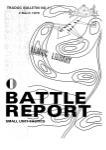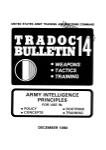/
Tags: warfare intelligence communities
Year: 1982
Text
SQUELCH CAPTURE
*— This pubHcation-is- reqtrirod-for official use- or .for-----
•““-arhrrirrtstrative-eroperattorial purposes-erdyr-Distribu—-
1 I IQ nnt/arnmaix± onanoinc —-
TRADOC BULLETIN NQ,15
22 JANUARY 1982
requests’far thfs_rfacnjn7ent-nTtistbereferred-to--&S-R-;—
REPORT DOCUMENTATION PAGE Form Approved 0MB No. 0704 0188
Public reporting burden for this collection of information is estimated to average 1 hour per response, including the time for reviewing instructions, searching existing data sources, gathering and maintaining tha data needed, and completing and reviewing the collection of information. Send comments regarding this burden estimate or any other aspect of this collection of information, including suggestions for reducing this burden, to Washington Headquarters Services, Directorate for Information Operations and Reports, 1215 Jefferson Davis Highway, Suite 1204, Arlington, VA 22202-4302, and to the Office of Management and Budget. Paperwork Reduction Project (0704-0188), Washington, DC 20503.
1. AGENCY USE ONLY (Leave blank) 2. REPORT DATE 22 JANUARY 1982 3. REPORT TYPE AND DATES COVERED FINAL
4. TITLE AND SUBTITLE TRADOC BULLETIN 15. BATTLE REPORT. SQUELCH CAPTURE. 5. FUNDING NUMBERS
6. AUTHOR(S)
7. PERFORMING ORGANIZATION NAME(S) AND ADDRESS(ES) HQ U.S. ARMY TRAINING AND DOCTRINE COMMAND ATTN: ATDO-C FORT MONROE VIRGINIA 23651 8. PERFORMING ORGANIZATION REPORT NUMBER
9. SPONSORING 1 MONITORING AGENCY NAME(S) AND ADDRESS(ES) 10. SPONSORING 1 MONITORING AGENCY REPORT NUMBER
11. SUPPLEMENTARY NOTES See TRADOC Bulletin 14 dated December 1980. This bulletin is the last in the series.
12a. DISTRIBUTION / AVAILABILITY STATEMENT APPROVED FOR PUBLIC RELEASE; DISTRIBUTION IS UNLIMITED. 12b. DISTRIBUTION CODE
13. ABSTRACT (Maximum 2QO words) This report informs Army operating forces of problems created by Threat interference of communications nets and its effect on command, control, and communication capabilities. It specifically addressed Warsaw Pact VHF jamming capabilities used against the US AN/VRC-12 series radios—the radios used most frequently in US Army tactical units. Included are actions that individuals and units can take to combat VHF jamming and countermeasures now being considered by the Dept of the Army. Squelch capture is the capability of some Threat jammers to prevent friendly communications from being received on VRC-12 series radios. It is one of the most serious threats to US military tactical FM communications. While all enemy jammers pose a threat to communications, some have a more serious effect than others. In the case of VRC-12 weries radios, Threat jammers are able to transmit signals that prevent friendly transmissions from being heard without the victim operator knowing that his radio is being jammed. The effect on te VRC-12 radio receiver from this type of jamming is called the squelch-capture effect. 20010803 035
14. SUBJECT TERMS 15. NUMBER OF PAGES 8
16. PRICE CODE
17. SECURITY CLASSIFICATION OF REPORT UNCLASSIFIED 18. SECURITY CLASSIFICATION OF THIS PAGE UNCLASSIFIED 19. SECURITY CLASSIFICATION OF ABSTRACT UNCLASSIFIED 20. LIMITATION OF ABSTRACT UNLIMITED
NSN 7540-01-280-5500
Standard Form 298 (Rev. 2-89)
Prescribed by ANSI Std. 239-18 298-102
USAPPC V1.00
UNITED STATES ARMY
TRAINING AND DOCTRINE COMMAND
BULLETIN NO 15
BATTLE REPORT:
SQUELCH CAPTURE
Battle reports are intended to provide timely, technical information on
weapons, tactics, and training to commanders and others concerned with
military training. They are not intended to supplant doctrinal publications,
but to supplement how-to-fight material with data derived from tests, recent
intelligence, and other sources.
NOTE: Information contained in this bulletin may be extracted for
individual use.
Comments and recommendations are welcome and should be directed to
HQ TRADOC, ATTN: ATDO-C, FORT MONROE, VA 23651,
(AUTOVON 680-3891/3451).
When used in this publication, “he,” “him,” “his,” and “men” represent
both the masculine and feminine genders unless otherwise stated.
Contents
Page
INTRODUCTION.................................... 2
WHAT IS SQUELCH CAPTURE?........................... 2
HOW TO COUNTER SQUELCH CAPTURE .................... 4
SUMMARY ......................................... 6
1
TRADOC BULLETIN 15
BATTLE REPORT
Introduction
Various electronic devices will be used on the modern battlefield to com-
mand and control operating forces and weapon systems. The enemy will
attempt to disrupt, destroy, and deceive friendly command and control by
means of electronic combat. This report informs Army operating forces of
problems created by Threat interference of communications nets and its
effect on command, control, and communication capabilities. It specifically
addresses Warsaw Pact VHF jamming capabilities used against the US
AN/VRC-12 series radios—the radios used most frequently in US Army
tactical units. Included are actions that individuals and units can take to
combat VHF jamming and countermeasures now being considered by the
Department of the Army.
What is Squelch Capture?
Squelch capture is the capability of some Threat jammers to prevent
friendly communications from being received on VRC-12 series radios. It is
one of the most serious threats to US military tactical FM communications.
While all enemy jammers pose a threat to communications, some have a
more serious effect than others. In the case of VRC-12 series radios, Threat
jammers are able to transmit signals that prevent friendly transmissions
from being heard without the victim operator knowing that his radio is
being jammed. The effect on the VRC-12 radio receiver from this type of
jamming is called the squelch-capture effect.
2
BATTLE REPORT
TRADOC BULLETIN 15
HOW IT OCCURS
The VRC-12 receiver is activated by a control tone that, when received,
deactivates the noise squelch control and allows the operator to hear
incoming transmissions. In other words, when the microphone switch is
depressed, a signal from the VRC-12 transmitter electronically opens the
intended receiver so voice transmissions can be heard. The signal cannot be
heard by the operator. When squelch capture occurs, the jammer blocks out
the control tone so that the receiver never opens, and, therefore, no com-
munications are received. When the squelch control is in the on position, no
sound at all is heard at the receiver. When it is in the off position, a slight
increase in the rushing sound may be heard when it is jammed. The jammer
also prevents the call light from illuminating. Although VRC-12 series
radios are designed to limit outside radio interference, they are extremely
vulnerable to squelch capture. The following illustrates how an enemy
jammer can be effective against friendly communications.
HOW IT IS IDENTIFIED
Although the operator of the VRC-12 radio may be unaware that his radio
receiver is being jammed, he should be suspicious if the receiver call light
does not illuminate and if he does not receive any radio transmissions for
long periods of time. If he does suspect jamming, he can confirm this by
switching to other radio frequencies to check radio traffic on other com-
munications nets. If he can hear transmissions on other frequencies, he can
assume that his radio frequency has been jammed (captured). He should
report this, up through the chain of command, so that the appropriate action
can be taken, such as changing to an alternate radio frequency.
3
TRADOC BULLETIN 15
BATTLE REPORT
How to Counter Squelch Capture
Many Army publications contain information about countermeasures to
use if a radio frequency is jammed. Operator manuals for radios, field SOPs,
and other current documents describe techniques to counteract jamming.
For the most part, these publications cover jamming signals an operator can
hear over a VRC-12 receiver, and the actions described in them are still
valid. But, since Threat jammers are able to block out VRC-12 radio receiver
signals, operators must know what actions to take when nothing can be
heard.
WHAT UNITS SHOULD DO
Commanders must train radio operators on specific actions to take when
they experience long periods without receiving communications. Some of
those actions follow:
Site radio equipment properly and use terrain for masking.
(Since jammers are line of sight to the targeted receiver, their effect can
be severely hindered through good terrain masking.)
Use an alternate method of communicating, such as messenger, land-
line, wire, or high frequency communications, when available.
(An alternate method will already have been identified if detailed prior
planning and coordination have been accomplished.)
4
BATTLE REPORT
TRADOC BULLETIN 15
Establish shorter link distances between stations to reduce jamming
effectiveness.
(Link distance is the distance between a transmitter and receiver
operating on the same frequency. The two significant variables used to
determine jamming range are link distance and the distance between
the jammer and the target receiver.)
Transmit critical messages in the blind when contact with another
station cannot be made.
(Remember, transmitters are not jammed, and other stations in the
communications net may not be in the line of sight of enemy jamming
equipment.)
For example, the graphic above shows a situation where an enemy
jammer has effectively jammed station B. Even so, station A can
receive messages from station В because the hill mass between the two
stations prevents the enemy jammer from getting radio line of sight
with station A’s receiver. Once received, station A can transmit the
message to its destination or relay it.
Employ other tactics as discussed in TC 32-11, How to Get Out of A Jam.
5
TRADOC BULLETIN 15
BATTLE REPORT
WHAT SERVICE SCHOOLS SHOULD DO
Until VRC-12 series radios are provided a jamming recognition
capability, service schools must emphasize techniques to combat the
squelch-jamming-capture effect. Also, the schools must insure that pro-
grams of instruction (POI) include a detailed description of squelch capture.
WHAT DA IS DOING
The effects of electronic jammers on VRC-12 radio receivers, as presented
in this report, and their impact on equipment improvement are of extreme
importance. Therefore, existing VRC-12 series radios and future equipment
must be updated to provide them with a jamming recognition capability.
Among the actions initiated to accomplish this are the following:
The commander of the Communications-Electronics Command
(CECOM) has submitted an equipment product improvement proposal to
the Department of the Army for VRC-12 series radios. The proposal, cur-
rently awaiting DA approval and allocation of funds, would provide radio
operators with an audiovisual indication of a jamming signal.
DA action is underway to raise the priority of the steerable null antenna
processor (SNAP-1) for expeditious fielding. The SNAP-1 appears to be a
solution to squelch capture since it can detect incoming signals during jam-
ming and the VRC-12 receiver cannot.
Summary
Electronic jamming operations have been used and will be used in the
future to alter the course of battle. Because of the importance of jammers as
weapon systems, the enemy will continue to use jamming against US mili-
tary tactical communications. Survival and mission success in a modern
battlefield environment require that all personnel be able to recognize and
defeat enemy jamming efforts against them. Radio operators must use
countermeasures to combat the effects of jamming. Although they do not
provide a guarantee, countermeasures will reduce friendly vulnerability
and increase the probability of successful communications.
6
TRADOC BULLETIN NO 15
22 JANUARY 1982
General, United States Army
Commanding
DISTRIBUTION:
Active Army: To be distributed in accordance with DA Form 12-11B, Requirements for Signal
Security (Qty rqr block no 322) plus requirements for TRADOC Training Bulletins (Qty rqr
block no 432).
ARNG and USAR: To be distributed in accordance with DA Form 12-11B, Requirements for
TRADOC Training Bulletins (Qty rqr block no 432).
Additional copies can be requisitioned from the US Army Adjutant General Publications
Center, 2800 Eastern Boulevard, Baltimore, MD 21220.



